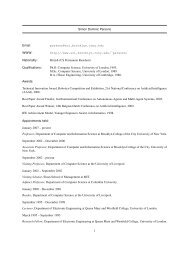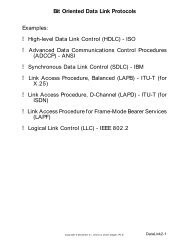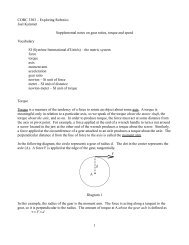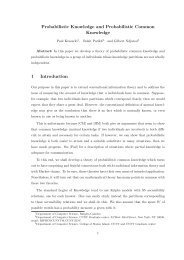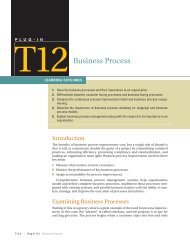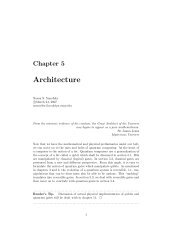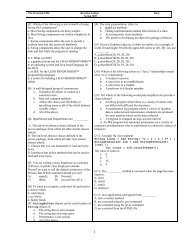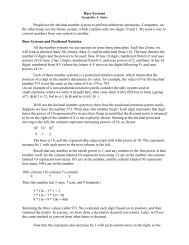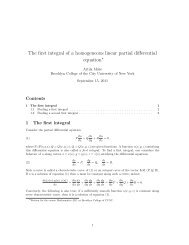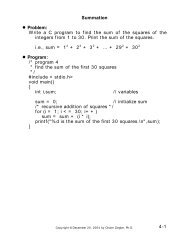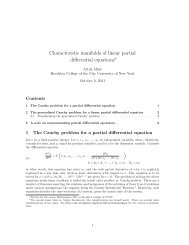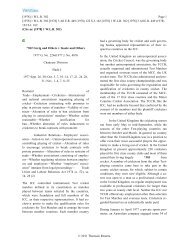RoboLab Icons Reference Sheet CORC 3303 – Joel Kammet
RoboLab Icons Reference Sheet CORC 3303 – Joel Kammet
RoboLab Icons Reference Sheet CORC 3303 – Joel Kammet
Create successful ePaper yourself
Turn your PDF publications into a flip-book with our unique Google optimized e-Paper software.
<strong>RoboLab</strong> <strong>Icons</strong> <strong>Reference</strong> <strong>Sheet</strong><br />
Motor A forward:<br />
Turns on the motor connected to output port A<br />
in the forward direction.<br />
Motor random:<br />
Turns on all motors (or the motors specified by<br />
attaching port modifiers) in a random direction.<br />
(Remember: a random direction, not random directions,<br />
meaning that all motors controlled by one of these<br />
icons will go in the SAME random direction.)<br />
Output port A modifier:<br />
When attached to a motor command, indicates<br />
that the command applies to the motor connected to<br />
Output Port A.<br />
Input port 1modifier:<br />
When attached to a sensor command, indicates<br />
that the sensor is connected to Input Port 1.<br />
Wait for random time: causes the program to wait<br />
for a random time before executing the next<br />
instruction. (Waits 0-5 sec. or 0-N sec. where N is a<br />
number specified in an attached Numerical Constant.)<br />
Wait for N seconds, where N is a number<br />
specified in an attached Numerical Constant:<br />
causes program to wait for N seconds before executing<br />
the next instruction.<br />
Task split: splits the REST OF THE PROGRAM<br />
into two branches (tasks) which will be executed<br />
simultaneously. This implements multitasking. EACH<br />
task must have its own “End of program” icon.<br />
Start task(s): restarts all tasks or a task specified<br />
in an attached Numerical Constant.<br />
<strong>CORC</strong> <strong>3303</strong> <strong>–</strong> <strong>Joel</strong> <strong>Kammet</strong><br />
Motor C reverse:<br />
Turns on the motor connected to output port C<br />
in the reverse direction.<br />
123<br />
Turns off the motor or lamp connected to<br />
output port C<br />
Numerical Constant used as a modifier for various<br />
functions.<br />
Power Level 3 modifier:<br />
When attached to a motor-on command, indicates that<br />
the motor should run at power level 3.<br />
Wait for N hundredths of a second (where N is a<br />
number specified in an attached Numerical Constant):<br />
causes the program to wait for N/100 seconds before executing<br />
the next instruction.<br />
Wait for touch sensor: causes the program to wait until<br />
the touch sensor is pressed before executing the next<br />
instruction.<br />
End of program: indicates end of the program. Does<br />
NOT turn off output devices (motors, lamps) if they<br />
are running. (When multitasking, this indicates end of one<br />
branch of the program.)<br />
Stop task(s): stops all running tasks, or, if Numerical<br />
Constant 1 or 2 is attached, stops the corresponding<br />
(upper or lower) task.
Light Sensor Fork: (attach a Numerical Constant<br />
to this icon) splits program into two branches.<br />
When light sensor reading is greater than the attached<br />
constant, the program continues along the upper branch.<br />
Otherwise, program continues along the lower branch.<br />
The branches must be rejoined using a Fork Merge at<br />
some point before the end of the program.<br />
Fork Merge: used to rejoin branches of a program<br />
following a fork.<br />
Start of Loop: all commands between this icon<br />
and the End of Loop icon will be executed N<br />
times (where N is a number specified in a Numerical<br />
Constant attached to the Start of Loop icon).<br />
Jump: causes execution to jump to another point<br />
in the program. The next command to be<br />
executed will be the one immediately following the Land<br />
icon of the corresponding color.<br />
Some other useful facts to remember:<br />
Touch Sensor Fork: splits program into two branches.<br />
When touch sensor is released, the program continues<br />
along the upper branch. When touch sensor is pressed, the<br />
program continues along the lower branch.<br />
The branches must be rejoined using a Fork Merge at some<br />
point before the end of the program.<br />
Plays musical note C.<br />
End of Loop: all commands between this icon<br />
and the Start of Loop icon will be executed N times<br />
(where N is a number specified in a Numerical<br />
Constant attached to the Start of Loop icon).<br />
Land: indicates the point at which program execution<br />
continues after a jump.<br />
An arrow pointing towards the right on a motor icon indicates “forward”. An arrow pointing towards the left on a motor<br />
icon indicates “reverse”.<br />
Be sure that you understand the distinction between a fork and a task split. In a fork, only 1 of the 2 branches is executed<br />
at any given time, and the 2 branches of a fork always merge back together (using a fork merge icon) before the end of the<br />
program. In a task split, both branches are executed simultaneously (multitasking), and the branches NEVER merge <strong>–</strong><br />
instead, each branch (task) continues to its own end, marked by its own “End of program” icon.<br />
A musical note icon or a “play a sound” icon, in addition to playing the sound, also acts as a sort of “Wait for time” icon.<br />
The program “waits” while the sound is playing. This means that if a motor was turned on just before the musical note, the<br />
motor will run while the note plays even if there is no actual “Wait for time” icon after the motor icon.<br />
<strong>CORC</strong> <strong>3303</strong> <strong>–</strong> <strong>Joel</strong> <strong>Kammet</strong>


